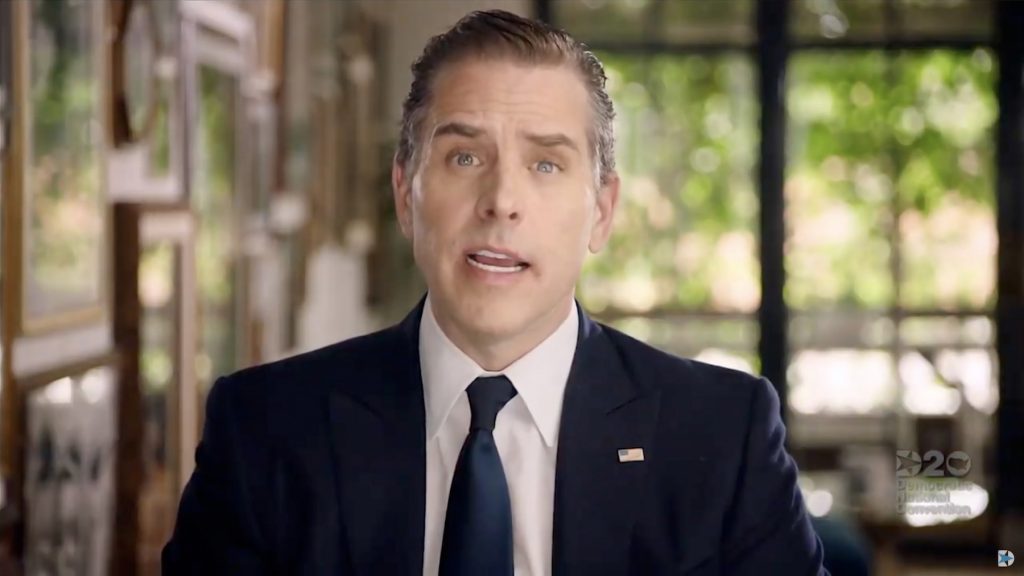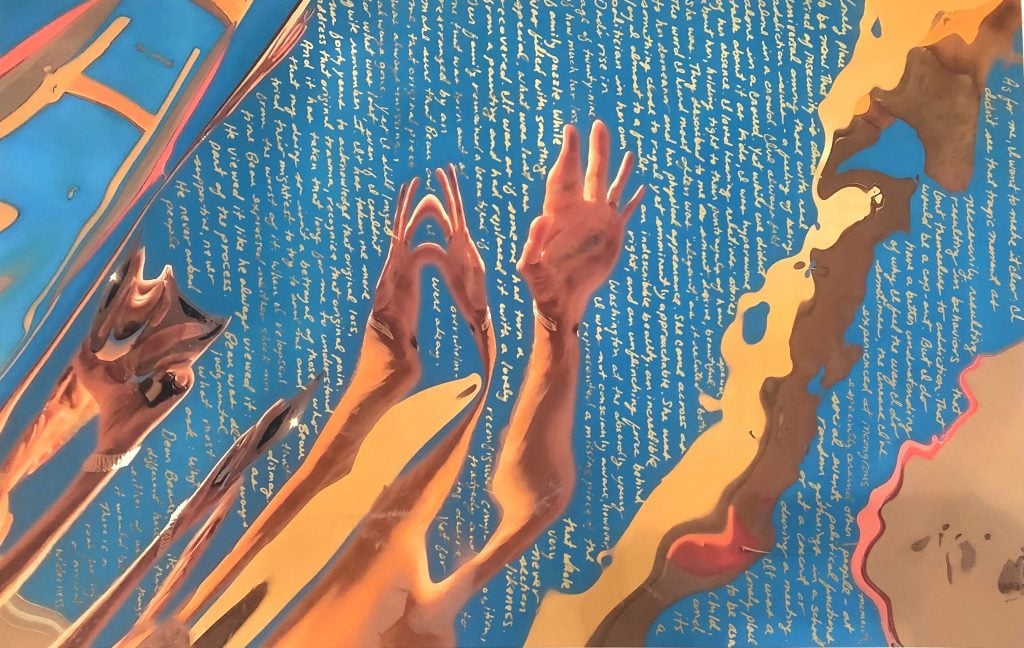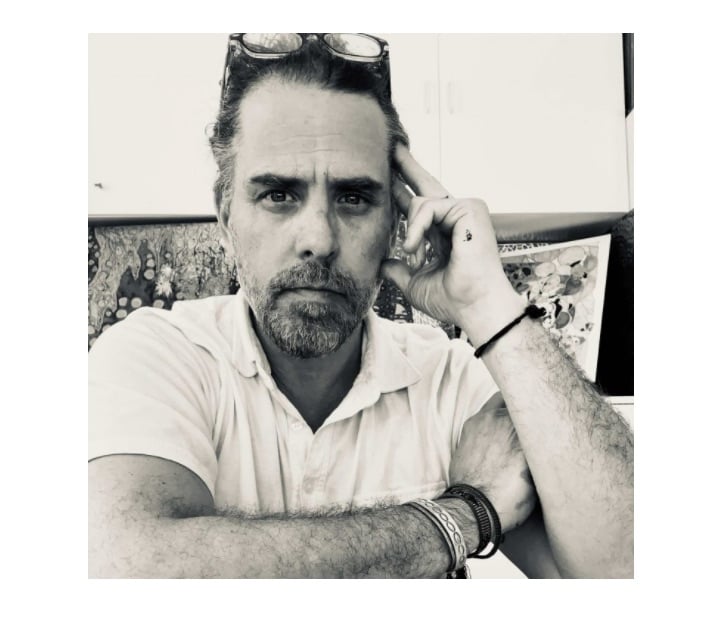Opinion
Hey Hunter Biden, Here’s a Radically Simple Solution for All Your Art Woes: Don’t Sell Your Work
If Hunter Biden wants his art to be received outside a political black box, his best bet is not to sell it.

If Hunter Biden wants his art to be received outside a political black box, his best bet is not to sell it.

Ben Davis

I don’t know what to say about Hunter Biden’s art. And by that, I mean I really don’t know. I haven’t seen it. Not very many people have, despite the epic viral-news explosion of interest in it recently.
All one has to go on are a few images from a New York Times profile from February last year and a few more released by gallery when it was revealed that Biden would be having a show there in October.
The former are the definition of meh; the latter evince a lot more development than I would expect. They’re not the worst thing a rich and powerful person’s son has ever put to paper and called art, put it that way.
But again: I haven’t seen them. Critical best practice is that you can’t judge an artwork based on its jpg: some things look much better in person. Some things look much worse.

Hunter Biden, Untitled (2021). Courtesy of the artist and Georges Bergès Gallery.
However, for the very reason that no one has seen them, the news that George Bergès is pricing them at $75,000 for drawings and $500,000 for paintings is gonna turn heads. Even if they were mind-bending contemporary-art breakthroughs, that would put Biden—who has never had an art show before, and started blowing ink on Japanese paper as a kind of therapy as he attempted to recover from multiple well-documented personal disasters—in the very top tier of emerging artists.
The whole thing is very, very weird. Prior to signing Hunter Biden, Bergès’s top media results had to do with his gallery representing Sylvester Stallone and the 12-year-old Xeo Chu, aka “Vietnam’s Jackson Pollock,” Now he is pitching himself as a kind of guru whose personal coaching shaped Hunter Biden from a hobbyist into a serious full-time artist. (Back in 2019, Hunter sought and failed to find gallery representation with the help of Lanette Phillips, a Hollywood producer and supporter of the elder Biden.)
Media interest in Hunter Biden’s art has now gone supernova because the White House was compelled to issue official ethics guidelines on his new career. Essentially, the buyers of his art will remain secret, to both Hunter and the White House, and “suspicious” clients will be rejected (though, exactly because it’s all secret, we are taking Sylvester Stallone’s art dealer’s word on who’s “suspicious.”)
Here’s a better idea: Don’t sell the artwork.
Hunter has very publicly talked about his struggles with living in the shadow of his father and his late brother, as well as his struggles with drugs and alcohol. “Painting is literally keeping me sane,” he told the Times in the profile that launched his art into the public eye, back when his dad was still floundering in the Democratic primaries. “For years I wouldn’t call myself an artist. Now I feel comfortable saying it.”

Hunter Biden, Untitled (2021). Courtesy of the artist and Georges Bergès Gallery.
In the same interview, he said that art-making “keeps me away from people and places where I shouldn’t be.”
And yet, under the influence of Bergès, he has seemingly been led directly back to where he shouldn’t be. The problems are so obvious, it reads like compulsive behavior of another variety.
In 2019, Hunter got the New Yorker profile treatment in an effort to get ahead of the drip-drip of revelations that the tabloids and political press were feasting on about his substance abuse issues, stints in rehab, living beyond his means, affair with his brother’s widow, and—the only part that’s the public’s business, really—his work as a lobbyist and lawyer for corrupt people like Patrick Ho. Hunter’s business dealings are a tender topic, because Burisma, the Ukrainian holding company through which Hunter at one time made a whopping $50,000 a month, was a big talking point for the ultra-corrupt Trump (whose own clan, of course, set a high bar for profiting off of the presidency).
But it’s not like only trolls were concerned. Here’s a passage from that New Yorker profile:
Several former officials in the Obama Administration and at the State Department insisted that Hunter’s role at Burisma had no effect on his father’s policies in Ukraine, but said that, nevertheless, Hunter should not have taken the board seat. As the former senior White House aide put it, there was a perception that “Hunter was on the loose, potentially undermining his father’s message.” The same aide said that Hunter should have recognized that at least some of his foreign business partners were motivated to work with him because they wanted “to be able to say that they are affiliated with Biden.” A former business associate said, “The appearance of a conflict of interest is good enough, at this level of politics, to keep you from doing things like that.”
The same thing goes for his art career. There is no way to sell original Hunter Biden paintings for $500,000 without some number of your collectors wanting “to be able to say that they are affiliated with Biden.”
The New York Post, clearly relishing the story, twists the knife this way: “[W]hen news broke last year that the 51-year-old former lobbyist and lawyer who has been at the center of bombshell scandals, including alleged corruption in his business dealings with China and Ukraine, Bergès said he has been inundated with calls from collectors eager to purchase the art.”
The art world is, in fact, under specific scrutiny right now for being a hotbed of corruption. The U.S. Senate Permanent Subcommittee on Investigations released a report last summer showing how Russian oligarchs used art’s veil of secrecy to dodge sanctions. Calling art “an environment ripe for laundering money and evading sanctions,” it agitated to expand the Bank Secrecy Act to target high-value art deals.
So there’s the potential for unsavory people to get in the mix. But Hunter’s out-of-the-blue gallery career also just ends up being a handy symbol, for anyone who is looking for one, of the more ambient corruption associated with both art and politics: that the wealthy and connected rise because other wealthy and connected people look out for them.

Screenshot of Hunter Biden’s artist photo from the Georges Bergès gallery website.
At any rate, the White House’s recently unveiled “what we don’t know can’t hurt us” approach to Hunter’s art career is the exact same approach Vice President Joe Biden made regarding Hunter’s business and earmarking work before. That did not work out.
From the New Yorker profile:
[Joe] Biden’s approach was to deal with Hunter’s activities by largely ignoring them. This may have temporarily allowed Biden to truthfully inform reporters that his decisions were not affected by Hunter. But, as Robert Weissman, the president of the advocacy group Public Citizen, said, “It’s hard to avoid the conclusion that Hunter’s foreign employers and partners were seeking to leverage Hunter’s relationship with Joe, either by seeking improper influence or to project access to him.”
The Bergès gallery’s description of Hunter Biden calls him a “lifelong artist that has devoted his artistic career to both the written word and the visual arts” and “a lawyer by trade who now devotes his life to the creative arts.” That is comically laboring to remove him from the political story, and only calling attention to it in the process.
I’m happy to take Hunter at his word that his art is a life-saving, therapeutic passion. “It’s something I’ve taken seriously for a long time but hasn’t necessarily been for public consumption,” he told the Times just last year. But if it is that, and he doesn’t want to have it buried beneath the political narrative, then the answer is simple: Don’t do this show now.